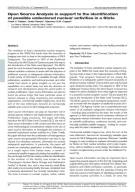Details
- Identification
- ISSN 1977-5296, DOI: 10.3011/ESARDA.IJNSNP.2018.8
- Publication date
- 1 December 2018
- Author
- Joint Research Centre
Description
Volume: 57, December 2018, pages 22-39
Authors: Frank V. Pabian1, Guido Renda2, Giacomo G.M. Cojazzi2
1Los Alamos National Laboratory Fellow, 2European Commission, Joint Research Centre, Directorate G – Nuclear Safety and Security
Abstract: The revelation of Iraq’s clandestine nuclear weapons program in the 1990s first made clear the necessity of bringing new tools to bear in the implementation of IAEA Safeguards. The adoption in 1997 of the Additional Protocol by the IAEA Board of Governors paved the way to the introduction of the State Level Approach. The IAEA’s quest for such increased transparency regarding nuclearrelevant activities continues to evolve with the adoption of additional sources of safeguards-relevant information. A wide variety of information is available through official publications, academic and technical journals, and other media from which to glean insights on not just the capabilities of a nation-state, but also the direction of research and development along the varied paths to nuclear proliferation. Open source Information can also be found via various blogs that have particular areas of interest relevant to treaty monitoring and verification organizations. Commercial satellite imagery has, since the turn of the new millennium, become an increasingly valuable open source for IAEA Safeguards purposes.
Open source information can play an important role in several aspects related to the implementation of the Non- Proliferation Treaty provisions. The paper will briefly introduce the IAEA State-Level Concept (SLC), the role of Open source information in this context and then focus on some methodological considerations related to the use of open source information to investigate the existence of potential undeclared nuclear activities in a State. Finally, the paper will show how the combination of heterogeneous open source and geospatial information can lead to sig. nificant, but otherwise unknown, information for nuclear safeguards applications. In particular, the paper will present an exemplary application, in which, following-up on a single report from Iranian news, a review of commercial satellite imagery (including that available costfree via Google Earth©) has made possible the identification of the location of the facility now known as the “Pasmangoor Nuclear Waste Storage and Stabilization Facility” in Anarak, Iran, and a new near-by small (likely pilot scale) ore processing facility that was completed near a previously abandoned, but recently reactivated, mine. The mine is known to contain copper, nickel, cobalt, arsenic, and uranium, making the new facility potentially of safeguards relevance.
Keywords: IAEA State-Level Concept, Open Source Analysis, Non-Proliferation
Reference guideline:
Pabian, F.V., Renda, G., & Cojazzi, G.G.M. (2018). Open Source Analysis in support to the identification of possible undeclared nuclear activities in a State. ESARDA Bulletin - The International Journal of Nuclear Safeguards and Non-proliferation, 57, 22-39. https://doi.org/10.3011/ ESARDA.IJNSNP.2018.8

